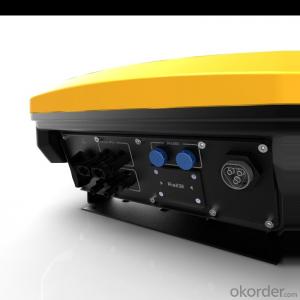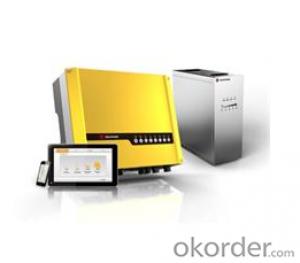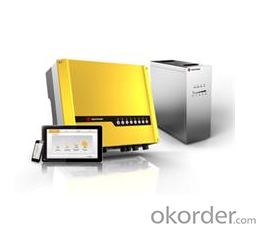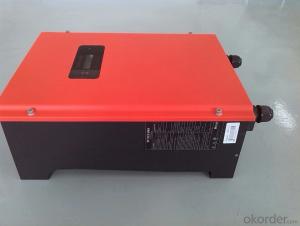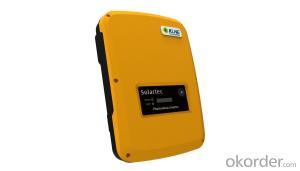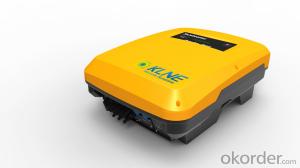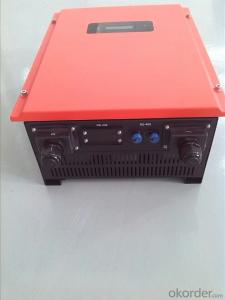Solar Inverter 500 Watt Off-Grid Type Solo-150 Series
- Loading Port:
- Shanghai
- Payment Terms:
- TT OR LC
- Min Order Qty:
- 10 unit
- Supply Capability:
- 1000 unit/month
OKorder Service Pledge
OKorder Financial Service
You Might Also Like
Product Description:
This system can keep 4 energy-saving bulbs with 15W working for 7 hours per day and a 5W radio working for 5 hours a day.
Output voltage: 5V d. c. (USB port) / 12V d. c.
It can work for 3 successive rainy days.
Powered by DC current
Can used out of doors
High effiency and low noise
FAQ
What is your payment terms?
We accept T/T payment, normally we need 20% T/T in advance, 80% payed before shipment.
What is your packing system?
We put the sistem in the wooden box.
Can you do OEM service?
Yes we can, but we need to do it with a certain order quantity.
● System voltage:12V
Ø
Ø
Ø
● Output DC current:6 phases
Product Datasheet:
Main Accessories | Specifications | No. | Notes |
Box | High-quality rolled steel | 1 | Standard box, optional colors |
PV modules | Polysilicon 150Wp | 1 piece | Optional |
Storage battery | Lead acid, maintenance-free, 160Ah | 1 piece | Optional |
Controller | Solo-LS1524S 15A | 1 unit | Standard |
PV accessories shelf | Simple type | 1 set | Optiona |
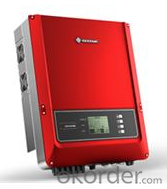
Product Advantages:
- Q: Can a solar inverter be used with a string inverter system?
- No, a solar inverter cannot be directly used with a string inverter system. A solar inverter converts the direct current (DC) generated by the solar panels into usable alternating current (AC) electricity. On the other hand, a string inverter manages the output of multiple solar panels connected in series, converting the DC power from the panels to AC power for the grid. These two types of inverters serve different functions and are not compatible with each other.
- Q: What is the role of a power optimizer in a solar inverter?
- The role of a power optimizer in a solar inverter is to maximize the energy output from each individual solar panel by optimizing the voltage and current levels. It ensures that even if one panel is shaded or underperforming, it does not affect the overall system performance. Power optimizers also provide real-time monitoring and diagnostics, allowing for better system maintenance and performance tracking.
- Q: What is the difference between low voltage grid connection and medium voltage grid connection?
- The difference is that the current at low voltage and the grid is large, the current is small when the voltage is small, followed by the low voltage crossing parameter setting problem (such as PV inverter integrated with inverter and low voltage crossing function, not all photovoltaic inverter
- Q: How does a solar inverter handle low light conditions or cloudy days?
- A solar inverter handles low light conditions or cloudy days by adjusting its power output to match the available sunlight. It utilizes Maximum Power Point Tracking (MPPT) technology to optimize energy conversion and extract the maximum energy possible from the solar panels even in low light conditions. This ensures optimal performance and efficiency of the solar system, allowing it to continue generating electricity even during cloudy days.
- Q: What is the role of power ramp rate control in a solar inverter?
- The role of power ramp rate control in a solar inverter is to regulate the rate at which the power output of the solar system increases or decreases. This control is important to ensure the stability and reliability of the grid, as sudden changes in power generation can cause disruptions. By gradually ramping up or down the power output, the solar inverter can respond to grid conditions and prevent overloading or underutilization of the system, ultimately improving the overall performance and efficiency of the solar installation.
- Q: Are solar inverters compatible with battery storage systems?
- Yes, solar inverters are compatible with battery storage systems. In fact, solar inverters are an essential component of a battery storage system as they convert the direct current (DC) power generated by solar panels into alternating current (AC) power, which can be used to charge and discharge batteries. This allows for the efficient integration of solar energy with battery storage, enabling users to store excess solar power for later use, improving energy independence and reducing reliance on the grid.
- Q: Can a solar inverter be used in regions with high levels of electromagnetic interference?
- Yes, a solar inverter can be used in regions with high levels of electromagnetic interference. However, it is important to ensure that the inverter is designed and manufactured to meet the necessary electromagnetic compatibility (EMC) standards and has the appropriate shielding measures in place to minimize any interference or disruption caused by electromagnetic noise.
- Q: What is the maximum number of solar panels that a solar inverter can support?
- The maximum number of solar panels that a solar inverter can support depends on the specific model and its capacity. However, most solar inverters are designed to support a certain capacity or power rating, rather than a specific number of panels. The capacity of the solar inverter, measured in kilowatts (kW) or megawatts (MW), determines the maximum power output it can handle. The number of panels that can be connected to the inverter depends on the power rating of each panel. So, it is best to consult the manufacturer's specifications or seek professional advice to determine the maximum number of panels that can be supported by a specific solar inverter.
- Q: How does a solar inverter impact the overall system reliability?
- A solar inverter plays a crucial role in ensuring the overall system reliability of a solar power system. It converts the direct current (DC) generated by solar panels into alternating current (AC) that is suitable for use in homes or businesses. By efficiently converting the energy and maintaining optimal voltage and frequency levels, the inverter ensures that the system operates reliably and consistently. It also provides various protective functions, such as monitoring and controlling the system's performance, detecting faults or abnormalities, and shutting down the system in case of emergencies. Therefore, a well-functioning solar inverter significantly impacts the overall system reliability by maximizing energy production, preventing damage, and ensuring smooth operation.
- Q: What is the role of a solar inverter in preventing electrical hazards?
- The role of a solar inverter in preventing electrical hazards is to convert the direct current (DC) power generated by solar panels into alternating current (AC) power that can be used in homes and businesses. By regulating the voltage and frequency of the electricity, the inverter ensures that the power is safe and compatible with the electrical grid. Additionally, solar inverters have built-in safety features such as ground fault protection and rapid shutdown mechanisms, which help prevent electrical hazards such as fires, shocks, and damage to the system.
Send your message to us
Solar Inverter 500 Watt Off-Grid Type Solo-150 Series
- Loading Port:
- Shanghai
- Payment Terms:
- TT OR LC
- Min Order Qty:
- 10 unit
- Supply Capability:
- 1000 unit/month
OKorder Service Pledge
OKorder Financial Service
Similar products
Hot products
Hot Searches
Related keywords
